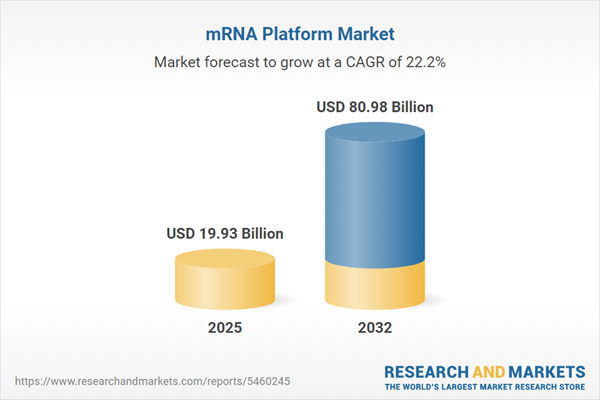Speak directly to the analyst to clarify any post sales queries you may have.
The mRNA platform market is accelerating significant transformation across healthcare and research, impacting therapeutics, diagnostics, and operational workflows. Strategic insight into this evolving sector is crucial for senior executives seeking sustainable competitive positioning, robust supply chain adaptation, and agile innovation frameworks.
Market Snapshot: Growth and Strategic Opportunities in the mRNA Platform Market
The mRNA platform market is growing rapidly, driven by advancements in delivery systems, innovative manufacturing methods, and scalable product development. Initially focused on vaccines, adoption now covers a wide array of applications including personalized therapeutics, diagnostics, and advanced research tools. Pharmaceutical companies, academic institutions, and contract manufacturers are engaging in collaborative models, enabling shorter development cycles and diversified pipelines. Strategic investment and synergy across the value chain are unlocking new paths to value creation as the market continues its expansion into both traditional and emerging healthcare applications.
Scope & Segmentation
This research report provides an in-depth analysis of the mRNA platform market, focusing on essential categories and stakeholders:
- Product Types: Diagnostics targeting cancer and infectious disease testing; Drug Discovery Reagents supporting screening and transfection protocols; Research Kits featuring lipid nanoparticles and mRNA synthesis tools; Therapeutics focused on cardiology, neurology, oncology, and rare disease solutions; and both prophylactic and therapeutic Vaccines for diverse health applications.
- Therapeutic Areas: Cardiology, with activity in arrhythmia and heart failure; Infectious Diseases, including COVID-19, influenza, and rabies; Neurologic conditions like Alzheimer’s and Parkinson’s disease; Oncology, addressing hematologic cancers and solid tumors; and Rare Diseases, including genetic and metabolic disorders that benefit from targeted approaches.
- End Users: Academic centers (colleges, universities), diagnostic laboratories (hospital-based and reference labs), hospitals from both public and private sectors, pharmaceutical companies from established leaders to emerging players, and research institutes that are either publicly or privately funded.
- Geographies: Americas—including North America (United States, Canada, Mexico) and Latin America (Brazil, Argentina, Chile, Colombia, Peru); Europe, the Middle East & Africa (notably the UK, Germany, France, Russia, UAE, South Africa, Nigeria, among others); and Asia-Pacific markets (China, India, Japan, Australia, South Korea, Indonesia, Thailand, Malaysia, Singapore, Taiwan).
- Key Companies: Major participants are Moderna, BioNTech, CureVac, Arcturus Therapeutics, Pfizer, Sanofi, GlaxoSmithKline, Vaxart, Gritstone bio, and Providence Therapeutics Holdings, each contributing to market evolution through technology leadership and diversified portfolios.
Key Takeaways
- mRNA platforms are reshaping healthcare innovation, shifting from conventional research models toward adaptable solutions that serve preventive, diagnostic, and therapeutic needs at scale.
- Improvements in lipid nanoparticle delivery systems and machine learning-based optimization are boosting both clinical safety profiles and gene expression efficiency across mRNA programs.
- More intricate regulatory frameworks challenge project timelines, but accelerated review options are enabling swifter launch of novel mRNA products in clinical settings.
- Increased collaboration among pharmaceuticals, biotechnology firms, and academic groups is driving resilience within supply networks while reducing time to market.
- Diversification in product pipelines now targets areas such as oncology, rare diseases, neurology, and cardiology, with each segment demanding specific deployment strategies for mRNA technologies.
- Management of intellectual property, particularly around delivery vectors and synthesis methods, is becoming a critical factor in securing competitive and market advantages amid broadening industry participation.
Tariff Impact: Supply Chain and Procurement Realignment
Planned adjustments to United States tariffs are prompting manufacturers and suppliers to review procurement and sourcing for mRNA platform components. The rising costs of importing specialized materials are encouraging the development of regional supplier networks and strengthening of domestic manufacturing agreements. These shifts help organizations mitigate cost volatility and maintain continuity in research and development pipelines. Healthcare providers and labs are reevaluating inventory strategies and contractual obligations to support operational resilience amid evolving regulatory environments.
Methodology & Data Sources
This report is based on a combination of primary research—through structured interviews with industry leaders—and secondary research drawn from peer-reviewed publications, patent documentation, and regulatory agency sources. These methods ensure precise insights and a reliable market analysis.
Why This Report Matters
- Arms senior decision-makers with actionable, current intelligence to inform investment, partnership, and operational strategies in the dynamic mRNA platform market.
- Highlights critical risks and emerging opportunities within the global product lifecycle, regional supply alignment, and shifting regulatory frameworks.
- Delivers an integrated view of market trends and key players, supporting strategies that leverage technology adoption and collaborative partnerships.
Conclusion
The mRNA platform market is advancing from early-stage innovation toward broad sector adoption. Senior leaders focusing on adaptive strategies, partnership building, and data-driven operations will be positioned to capture long-term growth and drive continued progress.
Additional Product Information:
- Purchase of this report includes 1 year online access with quarterly updates.
- This report can be updated on request. Please contact our Customer Experience team using the Ask a Question widget on our website.
Table of Contents
3. Executive Summary
4. Market Overview
7. Cumulative Impact of Artificial Intelligence 2025
Companies Mentioned
The companies profiled in this mRNA Platform market report include:- Moderna, Inc.
- BioNTech SE
- CureVac SE
- Arcturus Therapeutics Holdings, Inc.
- Pfizer Inc.
- Sanofi S.A.
- GlaxoSmithKline plc
- Vaxart, Inc.
- Gritstone bio, Inc.
- Providence Therapeutics Holdings Inc.
Table Information
| Report Attribute | Details |
|---|---|
| No. of Pages | 184 |
| Published | October 2025 |
| Forecast Period | 2025 - 2032 |
| Estimated Market Value ( USD | $ 19.93 Billion |
| Forecasted Market Value ( USD | $ 80.98 Billion |
| Compound Annual Growth Rate | 22.1% |
| Regions Covered | Global |
| No. of Companies Mentioned | 11 |









